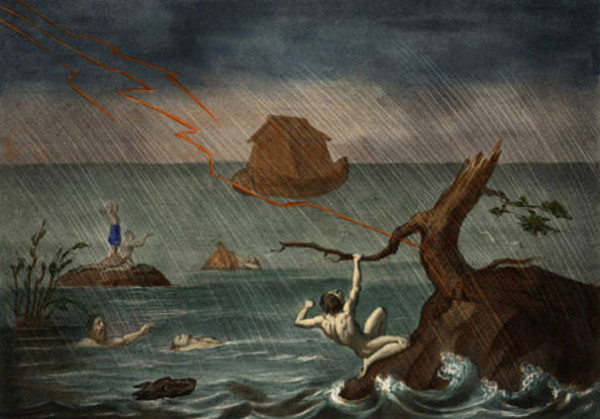How does science explain the miracles of the Bible?
The Bible says the universe was created in 6 days. Scientists say it takes about 13.8 billion years for the universe to take shape now.
Explain about the Bible from the perspective of scientists
But physicist Gerald Schroeder thinks that in a sense both are correct, when applying Albert Einstein's theory that time is relative . Schroeder, working at the Jewish University of Research, Jerusalem, declares 'time from the perspective of the other person to the Creator's perspective'.

The Bible says the universe was created in 6 days.(Photo: Corbis).
From Moses's possible overdose to climate change caused by the cataclysm of Noah, some scientists seek to explain the logic of each event in the Old Testament.
The formation of the universe

The Bible, the Koran and even Greek mythology all say life on Earth is made of clay.(Photo: PA).
'When the Bible describes the day-to-day development of the universe within six days of its appearance, it is true that the Bible wants to talk about six 24-hour cycles,' Schroeder wrote. 'But the time of the other universe'. He thinks that six days a day, 24 trillion hours will be roughly equivalent to 14 billion years as scientists.
Life formed from the earth
The Bible, the Koran and even Greek mythology all say life on Earth is made of clay. In ancient religious texts in Egypt and China, the Creator molded clay into people and blew life into it.
A 2013 study supported this hypothesis by saying that clay is a laboratory to nourish small unicellular organisms and chemicals that form life into the 'like a sponge'. That process lasts for billions of years when chemicals react to form proteins, then DNA is gradually living cells, according to Scientific Reports.
Adam and Eve

Richard Dawkins argued that we have the same ancestor: a black woman living in Africa.(Photo: WikiArt).
In the book River Out Of Eden, Richard Dawkins, an atheist, argued that we have the same ancestor: a black woman living in Africa 1/4 million years ago. He uses complex mathematical models to trace clues from human DNA.'There must be a woman who is the mother of mankind, the question is just where she is, and when, when there is such a person is certain.'
It was Eve, and about Adam, the common male ancestor of men appeared later, probably about 209,000 years ago, according to British researchers who have investigated the Y chromosome that formed men in humans.
Divided into Hong Hai

God is angry at human sins and decides to submerge the Earth (Photo: Corbis).
Another event in the Bible once explained by scientists is that Moses divided the Red Sea so that Israelis fleeing the army of Egyptian Pharaohs were pursuing them.
In 2010, Carl Drew, a researcher at the American Oceanic and Meteorological Research Center (NCAR), turned that run through the Red Sea into a computer model. He changed the direction of the east wind to a speed of 100 km / h and thought that this wind speed could indeed 'divide the water surface'.
Cataclysm

Scientists explained that Moses divided the Red Sea so that Israelis fleeing the army of Egyptian Pharaohs were pursuing them (Photo: WikiArt).
In the Book of Genesis, God is angry at the sins of men and decides to submerge the Earth, before ordering Noah to build a giant ship to save himself, his family and each animal in pairs. .
Researchers believe that during the warming phase of the Earth's temperature cycle around 5,600 BC, melting ice has caused rapid and strong sea level rise in the Mediterranean. The sea has swept across Bosporus' waist in Turkey, into the Black Sea, turning fresh water into saltwater today.
In the 1990s, based on archaeological evidence, two geologists from the University of Colombia, William Ryan and Walter Pitman, argued that the water had risen very rapidly every day for at least 300 consecutive days, submerging an area. land area of more than 155,000km.
- Dead Sea ancient texts reveal 'miracles' that 2,000 years of material did not disintegrate
- Tunnel where Jesus turned water into wine
- The mystery of the 2000 year old scroll
- Find evidence of the place of the demonic axis of God
- Revealing the oldest Bible in the world
- Discover the first Bible with illustrations
- 3D technology supports reading content of charred Bible copy
- Discover the mummy mask containing the oldest Bible copy
- Successfully decode the 1,500-year-old bible scroll
- Hidden text on the manuscript 'Dead Sea Bible'
- Write the Bible to make the clergy poisoned
- Artificial insemination - the reverse side of the miracle
 'Fine laughs' - Scary and painful torture in ancient times
'Fine laughs' - Scary and painful torture in ancient times The sequence of numbers 142857 of the Egyptian pyramids is known as the strangest number in the world - Why?
The sequence of numbers 142857 of the Egyptian pyramids is known as the strangest number in the world - Why? History of the iron
History of the iron What is alum?
What is alum?